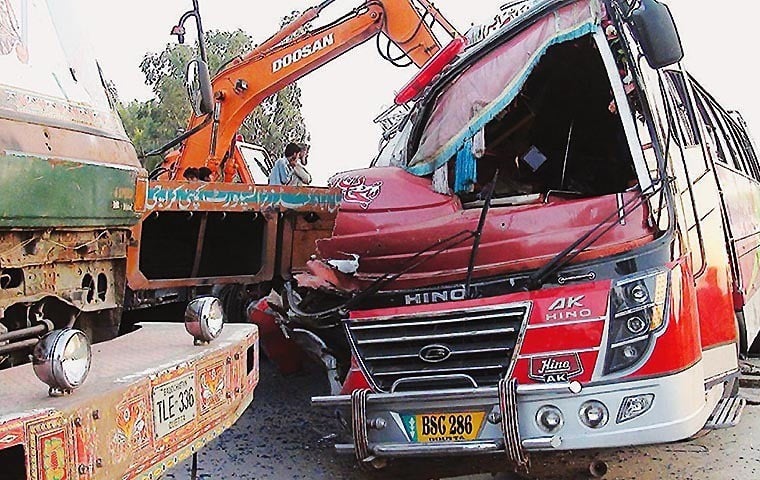
Signs and signals to ensure road safety disappear as one drives farther away from cities

It is February 24, and the sun is already set. I am driving with my family from our village to Islamabad on the Jhang-Gojra road. At 70-80 kilometres per hour, the steady stream of headlights of oncoming vehicles passes by smoothly. As the last vehicle crosses us, shockingly, I find a stationary tractor-trolley with no lights or reflectors on it, parked dangerously close to our vehicle. My reflexes are slow… the left side of our car smashes into the trolley.
My wife, sitting in the front seat, sustains critical head and eye injuries, my son’s nose is fractured, but my daughter and I get out of the car unscathed.
Fortunately, an ambulance approaches the scene of accident, taking us in time to the Tehsil Headquarters Hospital in Gojra (district Toba Tek Singh). After administering first aid to the injured, the doctors at THQ hospital, Gojra, refers them to the Allied Hospital in Faisalabad, where my wife remains hospitalised for a month. She has not yet recovered.
Accidents happen in seconds, in microseconds, but in retrospect the factors underlying their occurrence play in slow motion. I left to think, perhaps, the accident could have been averted -- if there were some glowing reflectors or a light on the trolley or any sign to caution the motorists. Or, maybe, if I was driving a bit slow…
Most road accidents happen at night as darkness compromises depth, perception, colour recognition and peripheral vision. Driving at night demands alertness, precaution and safety measures.
There is little sensitisation on traffic hazards in dark for motorists. Every driver hates the glaring high beams of oncoming traffic but no one likes to dim one’s own headlights. And, to top it all, hardly a traffic policeman monitors drivers and road safety at night.
While applying for a driving license, one comes across three kinds of traffic signs and signals. They are mandatory, warning and informative; usually found along roadsides or painted on the road surface. They tell motorists about speed limits, diversions, road conditions, turns, pedestrian zones, possible traffic hazards like landsliding, parking or no parking area, zebra crossing and more. Drivers may avoid accidents at night if these road signs are in glowing material.
Such signs and signals are spotted either in cities or roads linking big cities. They tend to disappear as we move farther to the remote rural areas.
Some signs are installed on vehicles, too, to indicate their length, speed limit, and loaded goods. Accidents involving heavy vehicles, over-loaded with cotton, sugarcane and iron-bars, may be averted if the extended load is made visible through appropriate lighting.
Slow moving vehicles (SMV) like tractor-trolleys, three-wheelers and carts pulled by animal are one of the major causes of road accidents at night. Slow moving vehicles are supposed to have a yellow triangle with glowing red border, a ‘SMV emblem’, on them. But how often, if ever, does one spot such an emblem on slow-moving vehicles? Or how often do the traffic police implement traffic rules on signs and signals?
Punishments in form of tickets are not always effective. Take the case of motorcyclists hastily wearing helmets at the sight of a traffic sergeant, and taking them off once they are out of their prying eyes. The traffic police need to look beyond the logic of punishment to ensure observance of traffic rules and road safety. The motorists need to be educated and sensitised on the road safety measures.
The traffic police in collaboration with the youth, local government representatives, educational institutions and public interest organisations can launch awareness campaigns on road safety. The money collected through issuance of traffic tickets can be spent on the awareness campaign, installation of traffic signs and pasting glowing stickers on SMVs.
According to a report in The News (August 23, 2015), 15 people die daily in traffic accidents in Pakistan on average. The Pakistan Bureau of Statistics bases the report on the statistics of road accidents from 2004 to 2013. If the government does not take some serious steps to have a robust road safety mechanism in place, the number of accidents and subsequent casualties, injured people and material losses are likely to increase.